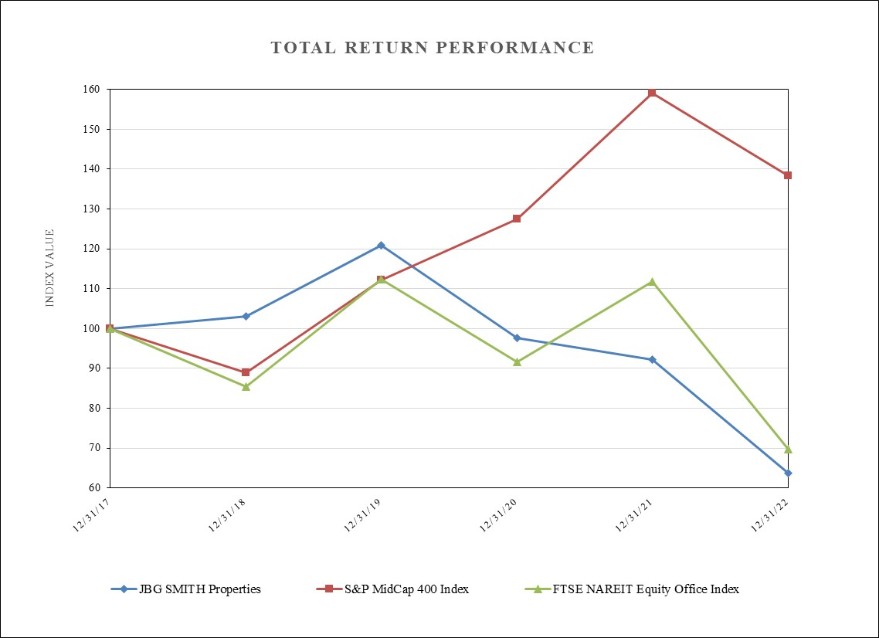Our success and our ability to implement and manage anticipated future growth depend, in large part, upon the efforts of our senior management team. Members of our senior management team have national or regional industry reputations that attract business and investment opportunities and assist us in negotiations with lenders, existing and potential tenants and other industry participants. The loss of services of one or more members of our senior management team, or our inability to attract and retain similarly qualified personnel, could adversely affect our business, diminish our investment opportunities and weaken our relationships with lenders, business partners, existing and prospective tenants and industry participants, which could have a material adverse effect on us.
The actual density of our development pipeline and/or any development parcel may not be consistent with our estimated potential development density.
As of December 31, 2022, we estimate that our 20 assets in the development pipeline will total 12.5 million square feet (9.7 million square feet at our share) of estimated potential development density. The potential development density estimates for our development pipeline and/or any particular development parcel are based solely on our estimates, using data available to us, and our business plans as of December 31, 2022. The actual density of our development pipeline and/or any development parcel may differ substantially from our estimates based on numerous factors, including our inability to obtain necessary zoning, land use and other required entitlements, legal challenges to our plans by activists and others, as well as building, occupancy and other required governmental permits and authorizations, and changes in the entitlement, permitting and authorization processes that restrict or delay our ability to develop, redevelop or use our development pipeline at anticipated density levels. We can provide no assurance that the actual density of our development pipeline and/or any development parcel will be consistent with our estimated potential development density.
The occurrence of cyber incidents, or a deficiency in our cybersecurity, or the cybersecurity of our service providers, could negatively impact our business by causing a disruption to our operations, a compromise or corruption of our confidential information, regulatory enforcement and other legal proceedings and/or damage to our business relationships, all of which could negatively impact our financial results.
A cyber incident is any intentional or unintentional adverse event that threatens the confidentiality, integrity, or availability of our information resources and can include unauthorized persons gaining access to systems to disrupt operations, corrupting data or stealing confidential information. The risk of a cyber incident or disruption, including by computer hackers, foreign governments and cyber terrorists, has generally increased as the number, intensity and sophistication of attempted attacks have increased globally. As our reliance on technology increases, so do the risks posed to our systems – both internal and external. Our primary risks that could directly result from the occurrence of a cyber incident are theft of assets; operational interruption; regulatory enforcement, lawsuits and other legal proceedings; damage to our relationships with our tenants; and private data exposure. A significant and extended disruption could damage our business or reputation, cause a loss of revenue, have an adverse effect on tenant relations, cause an unintended or unauthorized public disclosure, or lead to the misappropriation of proprietary, personally identifying, and confidential information, any of which could result in us incurring significant expenses to resolve these kinds of issues. Although we have implemented processes, procedures and controls to help mitigate the risks associated with a cyber incident, there can be no assurance that these measures will be sufficient for all possible situations. Even security measures that are appropriate, reasonable and/or in accordance with applicable legal requirements may not be sufficient to protect the information we maintain. Unauthorized parties, whether within or outside our company, may disrupt or gain access to our systems, or those of third parties with whom we do business, through human error, misfeasance, fraud, trickery, or other forms of deceit, including break-ins, use of stolen credentials, social engineering, phishing, computer viruses or other malicious codes, and similar means of unauthorized and destructive tampering. A successful attack on one of our service providers could result in a compromise of our own network, theft of our data, legal obligations or liabilities, deployment of ransomware or a disruption in our supply chain or of services upon which we rely. Even the most well protected information, networks, systems and facilities remain potentially vulnerable because the techniques used in such attempted cyber incidents evolve and generally are not recognized until launched against a target. Accordingly, we may be unable to anticipate these techniques or to implement adequate security barriers or other preventative measures, making it impossible for us to entirely mitigate this risk. If any of the foregoing risks materialize, it could have a material adverse effect on us.
Pandemics and other health concerns, including COVID-19, could have a negative effect on our business, results of operations, cash flows and financial condition.

